European New Right - ENR
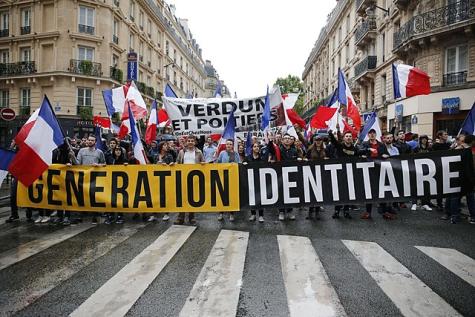
Who is the ➡️ Identitarian Movement? - Strategies, ideology and actions
The shift to the right in Europe is significant. The recent secret meeting of Potsdam, the participation of Martin Sellner from Austria, the New Far Right and the Identitarian Movement (IM) have once again come into the spotlight. The close connections of the right-wing leader Sellner and other IM activists to political parties such as the FPÖ, Rassemblement National or the AfD are nothing new. On the contrary: a right-wing movement has been forming for years from the streets to parliament. The vision of the „Mosaic Right” conjures up a right-wing counter-revolution that unites all right-wing groups and changes social narratives towards a climate of isolation, exclusion and division.
The Identitarian Movement is responsible for activism on the streets. They occupy mosques, disrupt anti-fascist demonstrations or attack a refugee play with fake blood. Ideologically, they are assigned to the New Right, which no longer refers directly to National Socialism, but rather propagates ethnopluralism. Behind this, however, is social Darwinism and a “modernized” racism. The group is listed as right-wing extremist across Europe.
Better World Info takes a critical look at the New Right and the Identitarian movement. We analyze the ideology represented, important features of the movement and its strategies for action. We also look at connections to other right-wing extremist organizations or parties.
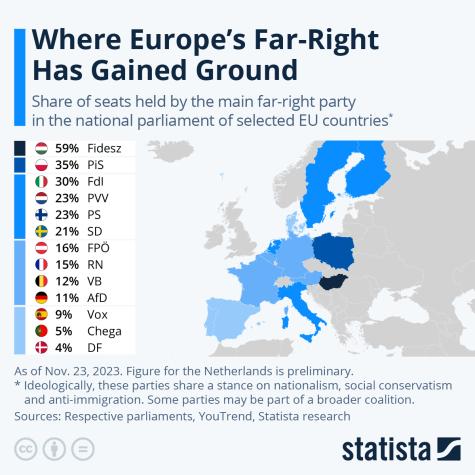
The Identitarian Movement as part of the New Right
The IM was founded in France in 2012. In the following months, branches were formed in various European countries, including Austria, the UK, Italy, Netherlands, Belgium and Germany. The Casa Pound movement in Italy, which was founded in 2003 and used left-wing forms of action such as squatting, style and rhetoric, to pursue neo-fascist politics, served as a role model.
But groups with an identitarian connection have also been founded outside of Europe, for example in the USA, Australia and Canada. The well-known American right-wing extremist Richard Spencer lobbied for an „American Identitarianism”. The American Alt-Right movement is strongly linked to the European New Right.
Both movements try to make right-wing extremist ideas socially acceptable through new narratives and linguistic codes and also rely heavily on the creation of right-wing cultural hegemony. The American right also supported the Identitarian movement organizationally and financially in the Defend Europe campaign. There are connections to the American neo-Nazi organization Identity Evropa, the white supremacy think tank National Policy Institute or the neo-Nazi Traditionalist Worker Party.
The goal of these movements: to form the actionist arm of the New Right. The New Right emerged as a counter-program to the 1968 movement and refers to the concept of the „Conservative Revolution”. Behind this is the idea of an anti-liberal and anti-egalitarian course that is based on attributes such as „elite, leadership, God, nation, nature, order, race and national community”.
The New Right also differentiates itself in its ideology from the Alt Right and its relationship to National Socialism. Key points of the IM ideology are the idea of separate ethnic groups that should exist in their own cultural and territorial spaces, as well as the rejection of multiculturalism. Ethnopluralism, a central component, includes the belief that the preservation of Europe's cultural and ethnic identity should be achieved by limiting migration and clearly demarcating different ethnic groups. Peoples are viewed as homogeneous groups and are primarily defined by their ethnic origins. In racism research, this is referred to as „racism without races”.
The IM takes the New Right approaches to the streets. These are theoretically founded by New Right philosophers like Alain de Benoist, Guillaume Faye, Armin Mohler or Henning Eichberg. Although they try to present themselves intellectually and non-violently, there have been repeated violent attacks against political opponents in the past and members regularly pose online at boxing and martial arts exercises. In this regard, it is also worth taking a look at the consistently high numbers of right-wing criminal and violent crimes all over Europe.

Right-wing extremism, nationalism and antisemitism
Although the IM try to distance themselves from classic neo-Nazism, the group is clearly right-wing extremist and is monitored by the Office for the Protection of the Constitution in Germany and Austria. The group was banned in France in 2021. There were several police raids in Austria in 2018; the accusation was that they had formed a criminal organization. In 2019, Martin Sellner's apartment in Vienna was searched again. The reason was a larger donation that the right-wing activist had received from the Christchurch terrorist, who killed more than 50 people.
Another central element is a stance against multiculturalism, which aims to prevent the supposedly threatening dilution of one's own cultural identity through the coexistence of different cultures. The IM vehemently rejects immigration, especially from non-European countries, and sees this as a threat to cultural homogeneity and social cohesion in Europe.
As a result, positions critical of globalization and capitalism are taken because the migration triggered by globalization would promote cultural „mixing”. Antisemitic positions are also represented, albeit at a lower level, leading IM activist Alexander Markovics comparing the refugee migration to Europe with the Holocaust. Both are „genocide” – the victim of the refugee migration would therefore be the „original” population of Europe.
Nationalism forms another cornerstone of the ideology. The IM emphasizes the importance of national sovereignty and rejects supranational organizations such as the European Union. The movement advocates a return to national borders and identities.
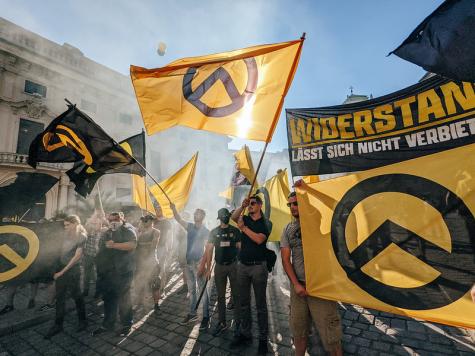
Right-wing activism and youth culture
Another aspect is the fight against the supposed “cultural Marxism” and "wokeness". The Identitarians claim that a left-wing ideology is undermining their culture and traditions and see themselves as defenders against this cultural threat. They represent conservative values and promote traditional family and gender roles.
The IM is characterized by features such as youthfulness, activism, pop culture and corporate identity. The members of the movement are on average between 15 and 35 years old. Actionism is at the forefront of political action. Demonstrations and interventions are repeatedly disrupted or buildings occupied. In Vienna in 2014, an IS execution was staged in public. In France, IM activists masked with pig heads stormed Muslim shops in 2010. In 2017, the IM chartered a ship to disrupt rescue missions in the Mediterranean.
The element of pop culture arises through merchandise such as the fashion label Phalanx Europa, the media agency Okzident Media or even produce own music as part of their communication strategy. The corporate identity results from the uniform symbolism. The movement's logo, a yellow lambda symbol on a black background, is used across countries. Campaigns are also initiated across Europe and fighting terms such as „Defend Europe" or „Reconquista" are coined, which are for the supposed liberation of Europe from multiculturalism and Islam.
Networking on the internet and on the street
The internet and social media play a very important role in this. Although the movement's accounts on Facebook, YouTube and Twitter were extensively blocked in 2020, with Elon Musk taking over Twitter, many of the IM activists have returned to the platform. In addition, TikTok and Telegram channels are mainly used. Martin Sellner reaches over 65,000 people on his Telegram account.
But the IM is also active outside of the internet. The movement continues to acquire houses. One example is the house project in Halle, Germany, which has been ongoing for years. This project also served as a model for the new right-wing movement. Because it acted as a hub between the right-wing think tank „Institute for State Policy”, the „Germania fraternity", the right-wing association “One Percent” and the AfD party.
These spaces are important networking and organizational points for the right-wing scene, which now operates from the streets to parliament. The personal connections between the various right-wing preliminary organizations, the AfD youth association Junge Alternative (JA) and the main party AfD are omnipresent and are being maintained increasingly openly. Gone are the days when people distanced themselves from the IM at the party political level. The common strategy is all about joining forces for a comprehensive right-wing movement.
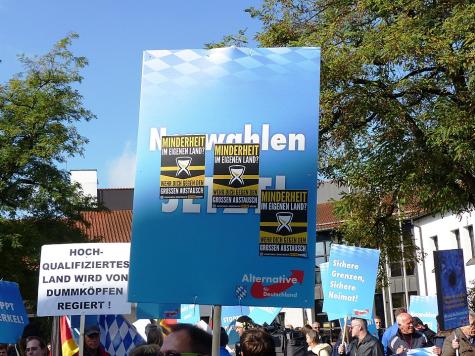
Connections between identitarians and right-wing parties
The connections between IM and the AfD, Rassemblement National, the UK Independence Party and the FPÖ are numerous. When the identity house project opened in Chemnitz, Germany, in 2023, several JA federal and state boards were on site at the inauguration ceremony. Even the AfD member of the Bundestag Roger Beckamp was demonstrably part of the event.
The Bundestag member Jan Wenzel employs the convicted right-wing extremist and IM activist Mario Müller in his office. The JA leader from Brandenburg meets regularly with Sellner and can be seen at IM demos, as does the AfD state parliament member Daniel Halemba, who was most recently wanted by the police for incitement to hatred.
The situation is similar in Austria. The cooperations are obvious there too - and not only since the current FPÖ chairman and top candidate Herbert Kickl called the IM an „interesting project worth supporting”. In 2021, an IM supporter and local FPÖ politician was arrested - he had planned an attack on the communist Vienna Volksstimme festival.
Kickl called the concept of „remigration”, „a trump card” and jokingly spoke of a „go-home plan”. It was introduced by the Austrian IM cadre Sellner and became public through the Potsdam secret meeting 2023 with AfD politicians.
In Great Britain, Sellner was scheduled to appear in front of members of the Young Independence party in 2018. There is also overlap between the IM in the UK and the National Front. In Sweden there are connections to the right-wing party Sweden Democrats, whose slogan "We are also a people!" was influenced by the IM ideology.
The long-time leader of the IM in France, Philippe Vardon, was part of the campaign team of Rassemblement National presidential candidate Marine Le Pen. In the municipal elections of 2020, and in the departmental elections the following year, several IM members were candidates for the far-right party. Le Pen has publicly defended the group several times. The parties spokesman Julien Odoul called members of the IM „whistleblowers".
The IM movement represents a function like a hinge between autonomous right-wing extremist circles and parliamentary right-wing parites. The IM cooperates with right-wing hooligans and neo-Nazi groups, engage them to protect demonstrations or form alliances like in Berlin in 2015 from HoGeSa Berlin, the NPD, Pro Deutschland and the regional IM branch. Many IM members come from national fraternities or were previously active in independent right-wing groups.
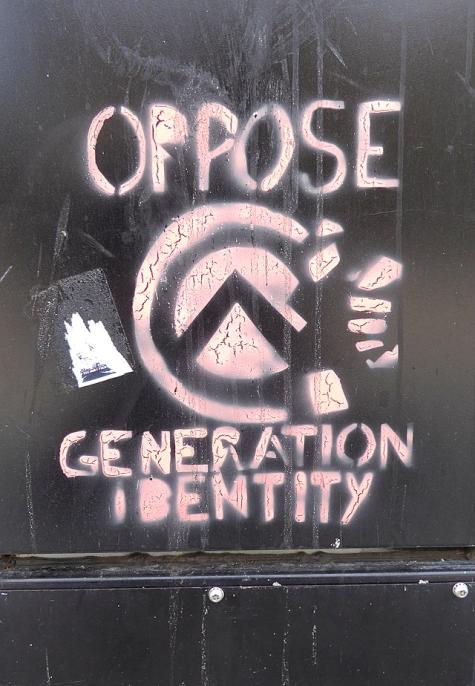
A broad right-wing movement as a danger
Through its student-intellectual demeanor on the one hand and through its activism on the other, the IM offers a broad area of contact that extends into the middle-class milieu. They have successfully managed to establish themselves as a right-wing extremist movement that appears to be more harmless and moderate than the baseball-wielding Nazi skinheads of the 1990s.
Through public relations work and a focus on social media, they have a high reach and political significance for the right-wing movement, considering their low number, which is estimated at just a few thousand activists all over Europe. Their hinge function also comes into play here. Due to their informal character, youth culture elements and high level of activism, they manage to appeal to young people better than a party could. Especially during the pandemic, they tried to gain low-threshold access to civil circles by taking part in demonstrations critical of Corona measures. As a street movement, they are less subject to public scrutiny or justification than a party when dealing with other right-wing extremist groups.
On the other hand, right-wing politics has now recognized the potential of the IM - as a mouthpiece for its politics on the street, as a subversive disruptive force against the established parties and as a right-wing youth culture that can inspire children and young people for right-wing ideologies. It is not surprising that there are hardly any credible demarcations between the right wing parties in relation to the IM - on the contrary. The parties are becoming increasingly open to the right-wing movement. They promote projects, support IM associations and appear publicly with well-known IM activists. The IM thanks them and are now also publicly advertising for the right-wing parties in the upcoming elections.
This shows the real danger: the right-wing movement is organized, broad and well networked. From the street to parliament, people know their role and support each other. How well this works can be seen in both Germany and Austria. The FPÖ is currently the force with the highest number of votes in the surveys for the 2024 National Council election. In Germany, elections will also take place in Saxony, Thuringia and Brandenburg in the fall. Although the AfD has lost support following the publications surrounding the secret meeting in Potsdam, it is still predicted to receive high votes in all three federal states.
The upcoming EU elections in June 2024 could also exacerbate the right-wing climate in Europe. Current surveys see gains for Europe's right-wing populist parties - which almost exclusively position themselves against the EU and are calling for its abolition.
It takes a lot to prevent the shift to the right in Europe: large progressive movements, more political education and new political concepts. Better World Info stands for a democratic and open society in Europe - and against hatred, exclusion and isolation. We are committed to human rights, social justice and dialogue. To this end, we support progressive efforts, provide content for political education and offer a platform for critical citizens or activists.
Author: Maximilian Stark 10.04.24, licensed under CC BY-NC-SA 4.0
For more information read below ⬇️
- European New Right - Wikipedia403070
- Identitarian movement - Wikipedia403084
- Ethnic nationalism - Wikipedia 405399
- Ethnopluralism - Wikipedia 405400
- Pan-European nationalism - Wikipedia 405401
- A Far-Right Takeover of Europe Is Underway - FP 13.03.24405403
- Right-Wing Extremism: German Identitarians Are Trying to make a Comeback - Spiegel 13.02.24405387
- This time, the far-right threat is real - Politico 06.02.24405391
- Who is Martin Sellner, the identitarian inspiring Europe's far right? - Le Monde 20.01.24405398
- Marine Le Pen tries to dissociate herself from violent far-right groups - Le Monde 23.12.22405389
- Today's far right and the echoes from history - SE 28.11.22405408
- Why the ideology of the 'New Right' is so dangerous - Conversation 02.11.22405416
- The allure of fascism: why do minorities join the far right? - Guardian 22.05.22405415
- Far-Right Extremism Is a Global Problem - FP 15.01.21405407
- No Child’s Play: The Identitarian Movement’s ‘Patriotic’ Video Game - GNET 17.09.20405413
- The Cultivated Extremist? How the Identitarian Movement Frames its Ideology - GNET 17.07.20405410
- Germany: Identitarian movement classified as extremist - DW 11.07.19405409
- How Europe's 'Identitarians' are mainstreaming racism - TWP 17.05.19405406
- Who are Europe's far-right identitarians? - Politico 04.04.19405402
- The Defend Europe campaign and the Identitarian movement in Europe - UIO 04.05.18405412
- How “identitarian” politics is changing Europe - Economist 28.03.18405404
- How to write history like an Identitarian - SPLC 14.02.18405388
- Meet the IB, Europe's version of America's alt-right - Economist 12.11.16405405
- American Racists Work to Spread 'Identitarian' Ideology - SPLC 12.10.15405411
- Video: The Resurgence of Europe’s Far-Right - YouTube 12.01.24405392
- Video: Far-right parties on the rise in Europe - DW 30.07.23405393
- Video: The Rise of France’s Far-Right Youth - Vice 16.07.21405395
- Video: The Rise of Italy's Far Right - Vice 28.05.21405396
- Video: Generation Hate - Al Jazeera 10.12.18405390
- Video: The hipster fascists trying to bring Mussolini back into the mainstream - Channel 4 02.03.18405397
- Video: The European hipsters who are appealing to the far right - SBS 25.04.17405394